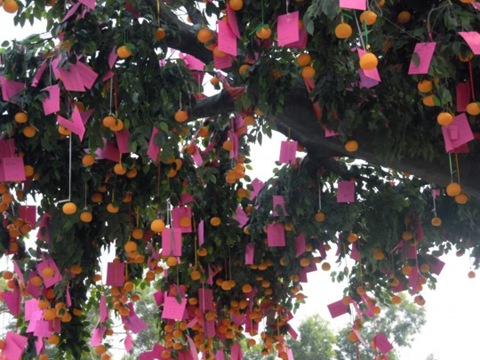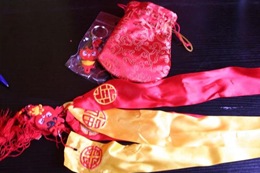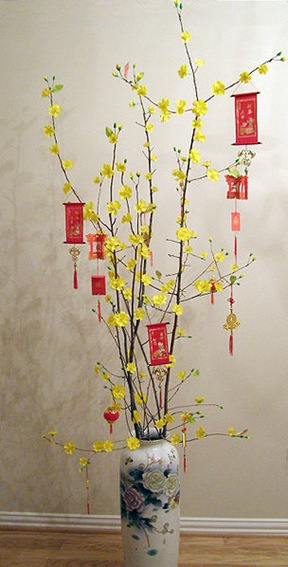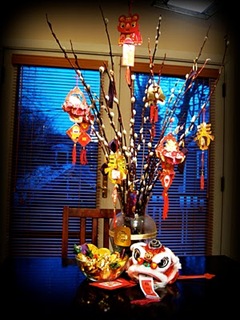Chinese wishing trees, money trees, orange trees, blossom trees, hong bao trees, even repurposed Christmas trees – they’re all part of the festivities as billions of people around the world celebrate day two of Chinese New Year. I thought it would be fun today to look at a variety of Chinese New Year trees and see how people use them – both as decorations and as part of Lunar New Year traditions. From kumquat and mandarin orange trees to apricot and peach blossoms, pussy willows and orchids, nature is doing its best to wish you a happy new year.

Above: Wishing Trees are a Lunar New Year tradition in many parts of Asia. For hundreds of years in Hong Kong, for example, people have been visiting the famous Chinese wishing trees in the village of Lam Tsuen. After writing their New Year wishes on colorful paper, they tied them to rocks - and in later years to lucky oranges - and tossed them up into the banyan trees. The belief was that if the wish adhered to the tree, especially on a high branch, the better the chance of it coming true.
In 2005 one of the trees finally cracked under the weight of this annual ritual. To continue it, a realistic-looking foam tree became the stand-in. Here it is, covered with wishes and foam oranges at Chinese New Year in 2011. Photo from Breathing Asia, Living Singapore.
At left: The Chinese wishing tree at Lam Tsuen is the subject of a great book for kids by Roseanne Thong.
In it she tells a beautifully moving story about a young boy and his grandmother who visit The Wishing Tree at each Chinese New Year.
When all of the boy’s wishes come true except for the most important one, the book becomes a lovely lesson in the importance of traditions, hope and love.

At right: At the Longhua Temple wishing tree in Shanghai, visitors purchase red silk pouches containing four ribbons. After writing a wish on each one, they hang them on the wishing tree outside the temple. Photo from Kristin Bair O’Keeffe.

All around the world people celebrate Chinese New Year with New Year trees of one form or another.
At left: In the southern part of Vietnam at Lunar New Year (Tet), flowering apricot branches like these yellow ones are used. In the north it’s peach blossoms. Photo from Wikimedia Commons.
Below: Here’s a display in Boston using pussy willow branches. Photo from Doubly Happy.


At right: Darryl Moland, Atlanta blogger and author of The Decorated Tree, designed this Chinese New Year tree using flowering branches and mercury glass ornaments by Martha Stewart.

Above left: Long considered auspicious symbols, money trees have been part of Chinese culture for at least 2,000 years. In earliest times, Taoist beliefs held that if a deceased person was buried with a money tree, the shiny coins decorating it would light his way to paradise. This Chinese money tree, made of bronze and glazed pottery, was created during the Eastern Han Dynasty (25 – 220). It’s from the collections of the Asian Art Museum in San Francisco.

Money trees are still popular today, especially during Chinese New Year. They’re believed to bring prosperity and solve financial problems and come in many forms.
At left: The metal money tree in this photo, from Savouring Thoughts, contains symbols as well as Chinese coins. Many are made entirely of coins and some are made of jade.

At right: Pachira plants, commonly known as money trees, are often given as gifts at Chinese New Year. They can range in height from several inches to seven feet, and often have braided trunks. Legend has it that the leaves will attract money and the braided trunk will keep it from slipping away.

At left: Red envelopes (hong bao) are undoubtedly the most popular decoration for Chinese New Year trees.That makes all the trees they appear on money trees by default!
The envelopes are traditionally filled with cash and given to children and unmarried adults. They’re also given as gifts to doctors and service people – and if you’ve ever attended a Chinese New Year parade, you’ve seen people hanging out of windows giving them to lion dancers. Photo by Jimmie Home School Mom.

At right: The most popular Lunar New Year trees of all have to be mandarin orange and kumquat trees. Oranges symbolize luck and good fortune, and potted trees loaded with them serve as holiday decorations in homes and businesses in many countries. The tree shown here is in a home in Vietnam. Photo from TST Tourist.
Below: Mandarin orange trees on sale for Chinese New Year at the Jordan Flower Market in Hong Kong. The more fruit on the tree, the luckier it is. Photo by Albert Ott.


Above: Colorful blossoms are a huge part of the traditions and enjoyment of Chinese New Year, representing happiness, good fortune and new beginnings. In most cities large flower markets spring up prior to the holiday, selling all kinds of beautiful plants for gifts and decorations. Flower shows held during the weeks of Chinese New Year are a holiday must-see tradition for many.
In this photo by Christopher Dewolf for CNN GO, pots of orchids large enough to be used as Chinese New Year trees are readied for sale at Mountain City Plants in Hong Kong.


Lastly, there seems to be a small but growing trend of repurposing Christmas trees as Chinese New Year trees. Rather than taking down their Christmas trees, some people are keeping them up and redecorating them for Lunar New Year. Here are two done up for the Year of the Dragon.
Above left: Photo from Julie K. in Taiwan. Above right: A dragon tree-topper by Kim of Musings From Kim K. See her entire New Year tree here.
If you enjoyed this post, why not subscribe to Pagoda Road by email and receive notification when new articles are published? It's free, only takes a minute to do and you can unsubscribe at any time. And please rest assured that your email address will never be sold, rented or used for any other purpose.


0 comments:
Post a Comment